Content
Creating service marketplaces has become a viral trend over the past few years, providing customers with high-quality and affordable service options and additional revenue streams for entrepreneurs. Given the current demand and the high number of success stories for service marketplaces, launching a platform people will use is not a trivial task.
With solid experience in building custom marketplaces of any type, we’d like to share experience-based insights to help you understand where to start and how to act to build a marketplace.
So, if you have an idea for a new business adventure or hesitate about whether it’s worth investing your time and money – this guide is your ready-to-follow roadmap.
What is a service marketplace platform?
A service online marketplace platform is an online e-commerce platform for buying and selling services. This solution acts as a bridge between customers and service providers, focusing on connecting the demand and supply of services such as freelancing, accommodation, tutoring, etc. Unlike product marketplaces that sell products, service marketplaces provide services.
As an entrepreneur, you can offer various services to meet the targeted demand and cater to a specific market. You may already use popular freelance service marketplaces like Fiverr – to hire experienced specialists, Uber – to get to a particular place, or Airbnb – to book or rent an apartment.


So, the services sector is massive. Still, there are many ways you can beat the competition by making buying services faster, easier, more affordable, and more reliable. Moreover, you don’t have to be a service provider since your providers create your supply. And if you’re worried about potential development challenges, build a service market tailored to your needs and capabilities with the help of reputable agencies like RewiSoft.
How the service marketplace works
The working process of an online service marketplace platform works as follows:
- Service providers list their offerings
- The service marketplace platform helps providers and customers meet to interact
- Buyers search through providers’ offerings and choose a particular service
- Buyers pay for the service via the marketplace’s payment system
- Marketplaces charge a commission on each transaction made
- Service providers obtain their share from the buyers’ payment
Types and examples of service marketplace platforms
There are many types of service marketplaces that you can consider as potential ideas for your service marketplace platform. Below, we’d like to share the most popular ones categorized by business domain and by participants.
By business domain:
- Travel marketplaces – provide travelers with accommodation (e.g., Airbnb, Booking.com)
- Education marketplaces – offer online educational courses in numerous subjects (e.g., Udemy, Coursera)
- Healthcare marketplaces – provides healthcare consulting services (e.g., Doctor on Demand), fitness and healthy lifestyles marketplaces like WellnessLiving)
- Freelance service marketplaces – offer services of remote specialists in different spheres (e.g., Fiverr, Upwork)
- Car services – such marketplaces provide taxi rides, carsharing, and ridesharing services (e.g., Uber, BlaBlaCar)
- Food delivery marketplaces – offers takeaways services offered by restaurants and cafes or food items delivered on demand (e.g., Uber Eats, Deliveroo)
- On-demand services – such marketplaces can operate in different niches (e.g., babysitting services like Bubble offers, housework services like TaskRabbit provides)
- Tool rental services – provides different tools for rent (e.g., Home Depot)
By participants:
- Customer-to-customer (C2C) or peer-to-peer (P2P) – individual buyers connect with individual sellers without a third-party intermediary between them, e.g., Uber
- Business-to-customer (B2C) – classic global selling model between businesses and consumers, e.g., Booking.com, Thumbtack, and VRBO
- Business-to-business (B2B) – focus on connecting businesses that offer services to companies that are looking to buy, e.g., Thales, Malt, and Caterspot
How RewiSoft builds a marketplace?
One of the latest examples of service marketplaces delivered by the RewiSoft team is an innovative marketplace for B2C industry professionals where they can find specialized vendors, their products, and their services.
The marketplace idea behind the project was to build a marketplace that would effectively help sellers to meet their client. As an example that we are proud of, we can cite a platform that is unparalleled – Zumi. Zumi is an all-in-one platform for tattoo artists and their clients that helps them connect with each other easily, seamlessly and quickly.
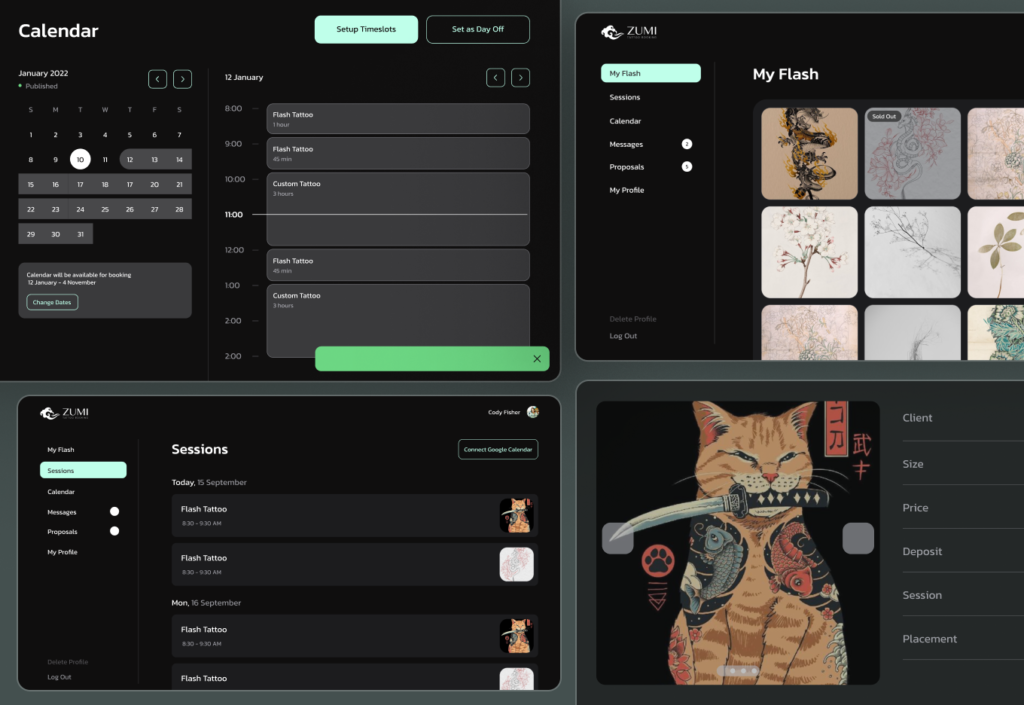

We carefully analyzed all the Customer’s ideas, collected requirements, and brainstormed this information to come up with the main challenges we needed to solve:
- Create a subscription-based platform for seamless access to the vendors’ services and products
- Level up the user experience
- Make the platform’s architecture flexible and scalable
The scope of features we’ve developed:
- Advanced search, which takes the user to the multifaceted search page and allows them to find what they need intuitively
- Favorites list to enable customers to add a specific artists to their favorites
- Personal profile so users can easily log in by entering their emails and password or using the social media option
- Listings page that represents a portfolio
- Subscriptions – to allow users to collect the needed company profiles in one place and access them with a few clicks
- Live chat for hassle-free communication
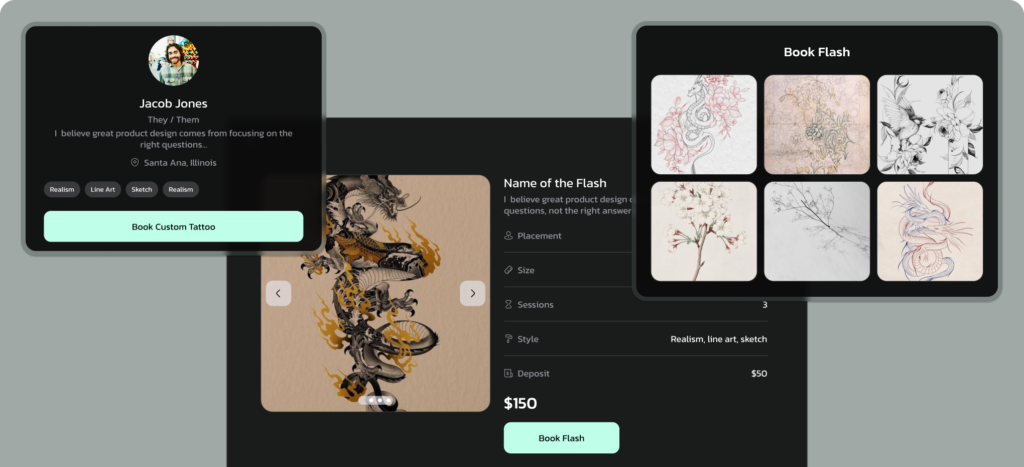

As a result, through our dedicated efforts, we successfully developed a scalable and uniquely innovative platform, Zumi, from the ground up. This platform has transformed the way tattoo artists connect with their clients, introducing a one-of-a-kind solution to the market. Our focus on usability has greatly streamlined the daily operations of tattoo artists, optimizing various aspects of their work. Moreover, our client has achieved significant fundraising success, enabling further development and expansion of this groundbreaking product.
Contact Us to discuss your project idea!
How to build a service marketplace in 7 steps?
Below, we show actionable steps you need to take to build a marketplace to set up the development and design workflow right and succeed despite high competition.


Step 1. Outline and validate your service marketplace idea
Before investing time and money into service marketplace platform development, businesses should clarify and validate their idea. This task is extremely important, as efforts to develop advanced functionality before collecting customer feedback and doing detailed industry and market research are not the key to success in the market.
To make your online marketplace idea viable, you should understand what you want to create, what type of marketplace you need, what features to include to address the pain points of two different user groups (customers and service providers), etc.
To find a profitable marketplace idea, the RewiSoft team recommends analyzing the market inefficiencies you’re focusing on, looking for underused assets, fragmented markets, or services where you can bring new value. Also, before building a new solution – validate the business idea to understand the users’ problems and how well your online marketplace idea can solve them.
Step 2. Go to product discovery
The next task is making a thorough product discovery that will help you develop a feasible development strategy, test your market idea, and create a unique value proposition to remain competitive and bring new value to service providers and customers.
For example, in our case, our primary goal was to build a marketplace for B2B industry professionals. The value of this marketplace lies in creating a marketplace that provides full-service management and outsourcing services for businesses seeking professional connections in a specific industry.
Let’s see how the product discovery process works at RewiSoft:
- We collect and analyze our customers’ requirements, business goals, ideas, nice-to-have features, and considerations regarding the project.
- We set up in-house brainstorming sessions to analyze the information and set the project’s goal.
- We conduct extensive market research to collect information about similar types of service marketplaces that exist in the market.
- We conduct competitor research to analyze the direct competitors’ weak and strong sides in the chosen industry.
- We draw up a primary user persona and analyze the target audience to understand better the core functionality the end users need.
- We define a unique value proposition and marketplace business model that align with your core business goals.
- We create technical documentation for the product/service.
- We choose a suitable monetization model.
- We create a list of essential features to implement.
- We define the timelines and set up a project budget.
Step 3. Start with MVP
Before investing resources into building a service marketplace platform, we recommend developing an MVP to validate the market demand and test the success of your MVP in solving the market’s problems.
Thus, start learning from real users and making revenue early on through MVP development. The MVP version of your service marketplace requires limited resources and efforts to market your service marketplace platform.


At RewiSoft, the process is simple: we develop core app features with a simple UI/UX design, test the app, collect user feedback, and continue online marketplace app development if the idea is worthy. This approach is the most optimal way to quickly and cost-effectively move from an idea to a successful product launch.
Useful tip: when building an MVP, ensure to include the necessary functionality to address the key pain points of your end users. That way, you will receive early feedback and create the next development iterations faster.
Step 4. Choose a monetization model
When you are starting to consider how to build an online service platform, it’s essential to create the right monetization strategy for your solution. You can choose many service marketplace business models to monetize your idea. The most popular ones are:
- Subscription fee. Sellers set a subscription and use extensive offerings on the marketplace. These offerings may include premium listings or services integrated with the platform. The payment is usually made monthly or yearly (for example, $15 per month for a subscription).
- Transaction fee. It is the fastest marketplace model to make your business generate quick income. With this model, sellers pay a fee only when they provide a service. The most famous examples applying this model are Fiverr and Airbnb – the marketplace charge a commission from each transaction made.
- Listing fee. Here, your marketplace charges a fee from users to join the platform or post a listing.
- Premium listings. If your vendors want to promote their listings and get to the top of search results, you can charge them, for example, $5 for a premium listing to get higher in the feed for a week.
- Advertising. With this revenue model, you can earn by advertising providers’ services and take a commission when a user clicks on a link and goes to the advertiser’s page.
Step 5. Create an attractive UI/UX design
Designers come into play during UI/UX design to conceptualize your service online marketplace idea. Since you deal with big competition among marketplaces and different customers, make it a rule to create smooth navigation, keep simplicity, and use design consistency. This way, your users use your successful marketplace hassle-free and choose your marketplace over other competitors.
The design process at RewiSoft works as follows:
- We assign 2+ experienced UI/UX designers in the related niche.
- Our designers actively engage in UI/UX research to study the target users, their pain points, needs, and goals.
- Designers describe the primary platform personas (e.g., public users, registered users, members of the company, admin, super admin, and supplier, as in our NDA project).
- Our designers develop and identify as many user scenarios as possible and create customer journey maps that will provide a clear insight into how users will interact with your online marketplace and reach their primary goal: buy and sell services.
- Our designers create a mood board with all images with textures, typography elements, color palettes, and other components.
- Designers create custom UI kits or design systems that contain all visual components of your platform, including animations, buttons, icons, checklists, menus, dropdowns, input elements, and logos (if required)
- Designers create a clear information architecture if the online marketplace contains a variety of functionality, many modules, and categories.
- Designers create UX wireframes and prototypes based on the information and sketches collected to visualize how the app looks and performs.
- Several prototypes are submitted for testing with real users so that we can make improvements if necessary.
The UI/UX design stage is essential to the product implementation to release visually appealing and easy-to-use and navigate marketplaces. So, following the best design practices is necessary to attract customers and achieve core business goals faster. So, keep reading to find out the best design practices for service online marketplace platforms!
Find out more about our end-to-end solution services!
Step 6. Develop and test your service marketplace
After agreeing upon the designed screens with all project stakeholders, it’s time to translate them into workable code. During the development stage, RewiSoft typically assigns 2+ experienced coders (for front-end and back-end development). The marketplace mobile app development process consists of the following steps:


- Product discovery. This step is essential to capture and analyze all customer requirements and validate your online marketplace concept to minimize potential rework and development costs.
- Technical documentation. During this stage, we compile technical documentation that includes technical specifications, selected technical stacks, and tools for future development. We estimate the project cost, set deadlines, and plan the scope of work.
- Architecture plan development. Our software development team creates a detailed architecture plan to sketch out the big picture of your platform. This entails: choosing a monolith or microservices and choosing the controllers and types of APIs for the back end; for the font end, we define how the business will interact with the product concept, objects, and user personas.
- Sprint planning. We divide the scope of work into sprints that last 2-4 weeks. For each sprint, we define the priority and task sequence to meet the expected results on time.
- Infrastructure setup + CI/CD. When the architecture plan is ready, we get to the entire platform infrastructure setup. We define databases and security services and select hosting providers at this stage.
- Client and server development. Our front-end and back-end developers write code for the product’s server and client side.
- QA and testing. We have scheduled multi-level testing to verify the service marketplace’s usability, performance, acceptability, and functionality. We conduct usability testing within our UX lab services. Our testers use the UX Eye Tracker to prevent usability gaps by exploring user behavior while interacting with the product.
- Regression testing. We perform regression testing to ensure that new and reworked components and features do not break existing functionality and fix bugs as needed.
- Production infrastructure setup + CI/CD to the prod servers. We set up a production environment for gradual deployment. We set up the domains and the system so that any changes we make to the product will automatically appear in this environment.
- Delivery. Our project managers monitor the work of the developers to ensure that the project is completed on time and with the expected quality.
Step 7. Launch and promote your business
After fine-tuning the functionality, we launch the online marketplace for the target audience, collect feedback and make reworks. However, creating a high-quality supply for your marketplace among service providers is better before launching it. So, we recommend dividing the service marketplace launch into a product launch and a marketing launch.
Before the marketing launch, you should create a long-term successful marketplace growth strategy, finding sellers and buyers to join your marketplace. Thus, you can start considering various ways to attract the target audience. The most efficient ones are content marketing, SEO optimization, link building, social media engagement through Facebook and Reddit, PR, influencer marketing, paid ads, sponsorships, and so on. That will take some time and some trial and error. However, the data you get allows you to learn what works well and what needs improvement. Also, you will lay a foundation to grow your service business long-term.
Key features of service marketplace platforms
To build a marketplace, you should offer both service providers and customers all features they need to use to have a great experience with your platform. Let’s highlight them.
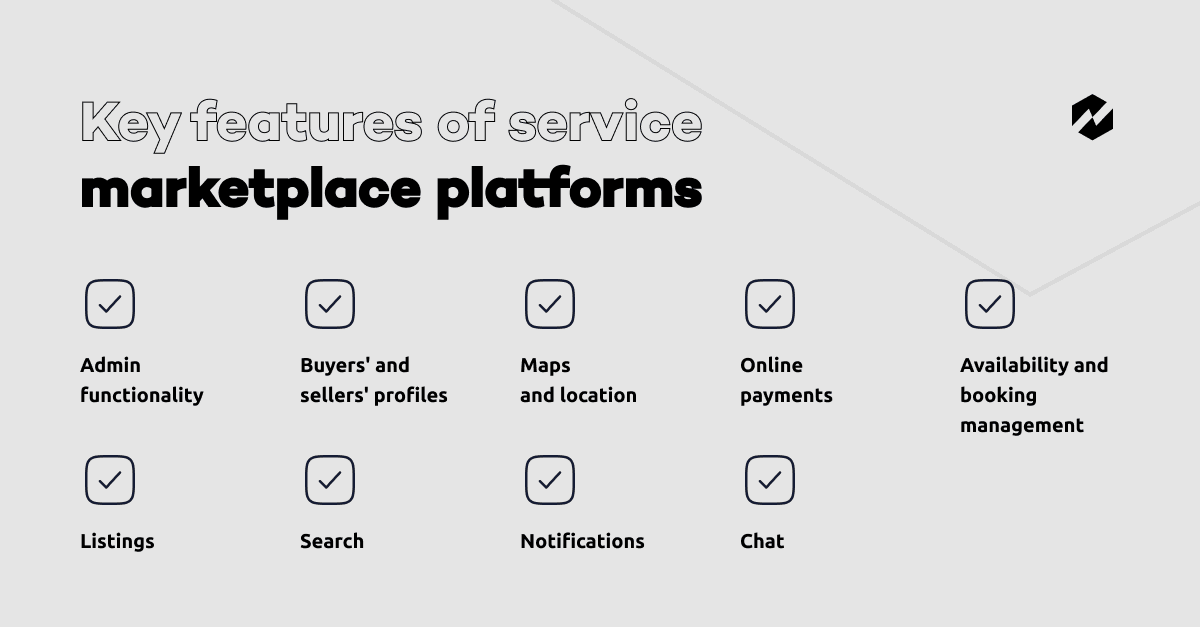

Admin functionality
Typically, you will need to build an admin dashboard to monitor and access your marketplace’s user profiles, transactions, messages, and reviews. By analyzing the collected data, you will be able to improve your platform and solve technical issues such as content moderation, user activity tracking, payment editing, etc.
Buyers’ and sellers’ profiles
User profiles for sellers and buyers should help both parties to access your platform and store personal information securely. Through sellers’ profiles, they can build a reputable brand and deal with customers. Customers, in turn, will be able to start using your successful marketplace.
The fields you should consider for sellers’ profiles include personal descriptions of themselves, their services, photos, testimonials, certificates, etc. The standard fields for customers are name, surname, location, phone number, and preferences regarding service delivery.
Listings
The service providers should have sufficient tools to showcase their services and offerings. The information displayed on the listings’ page varies depending on the type of your service marketplace platform.
For example, as in our NDA case, listings present information on photos and videos, contact details, product or service descriptions, communication options, address details, employees list, latest discussions, careers, recommendations, and questions.
Search
Customers should have sufficient tools to browse, search and filter listings based on their criteria. Search tools help customers find the services they need in several clicks as well as retain them want to use service providers’ offerings.
Online payments
Another crucial aspect to consider for your online marketplace is the implementation of a seamless and secure payment flow and deciding how you will take payment from buyers and pay your providers. Also, when building a marketplace, make sure to include digital and smartphone payments so customers can pay via any device via credit card or PayPal account.
Availability and booking management (dashboard)
Availability and booking management systems are crucial for your marketplace’s success. Service providers will be able to control their activities, accept or decline orders, manage the availability of their offerings, prevent double booking, and monitor the overall selling workflow.
Maps and location
This feature is essential to implement if you deal with local services like babysitting, photographers, car services, and other location-dependent services. In this case, you must allow your service providers to tag their location and allow your customers to search for listings based on location.
Notifications
Notifications can be an auxiliary service for customers to help them get notified of the scheduled activity. For service providers, notifications help keep them posted when they have new orders.
Chat
Chat is helpful to allow service providers to answer customers’ questions regarding their services. This feature improves your user experience by enabling customers to get all the answers and discuss the details before a deal.
Tech requirements to build a service marketplace
When it comes to service marketplace platform development – a lot is at stake. In order to ensure that your product meets your technical requirements, quality, and safety standards, we recommend considering the critical technical requirements that will affect the success and profitability of your marketplace.
Tech stack for a service marketplace
When it comes to the tech stack to create a service marketplace, we offer our customers the most cost-efficient and modern technologies and powerful tools. The choice of tech stack depends on the development approach (custom, SaaS, or white-label solution), the platform type, and your unique technical and business requirements.
Our team usually chooses the following technologies and tools to build a service marketplace platform.
For frontend service marketplace development, we usually use:
- Languages: HTML 5, CSS 3, JavaScript
- Libraries and frameworks: Angular, React, Vue.js
- Mobile frameworks: React Native, Flutter, Objective-C, Swift, Kotlin, Java
For backend service marketplace development, RewiSoft experts use:
- Languages: Python, C++, PHP, Java, Go
- Frameworks: Node.js, PHP (Laravel), Express
- Databases: MySQL, PostgreSQL, Redis
- Hosting: AWS, Google Cloud, Microsoft Azure
Development approach
While considering how to build an online service platform, another crucial factor is choosing the development approach that best suits your business and available resources. We recommend considering three of them: building a custom solution, licensing a SaaS product, or purchasing a white-label solution.
Let’s look at the pros and cons of both options based on the following criteria:
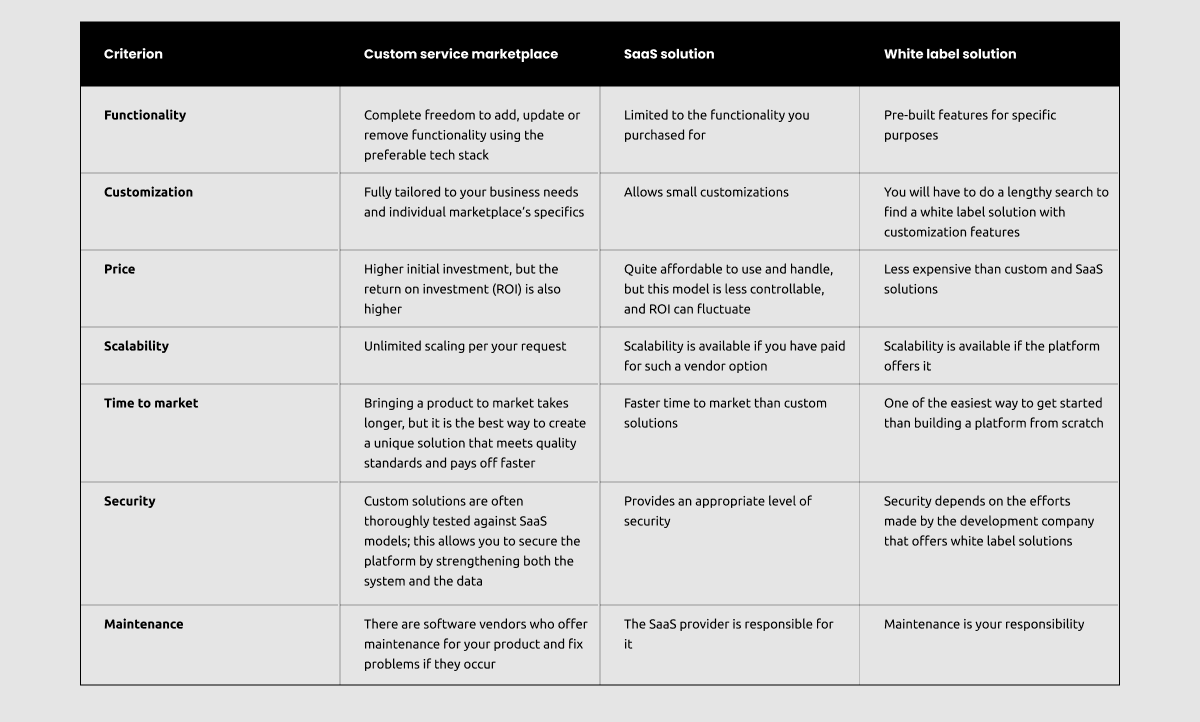

As you see, the choice is up to your needs, capabilities, and future goals. We recommend building a custom service online marketplace since such an approach allows you to create more tailored solutions to your needs. With custom solutions, you will be able to choose a technology stack and create an original user interface and flexible architecture. That will help you to make an original market story and ensure high competitiveness and unlimited scalability.
Data security and compliance with industry standards
Security and regulatory compliance are always top priorities, mainly when dealing with customers. Once you decide on the platform type, you should check what requirements your marketplace should comply with. The laws, standards, and regulations depend on the industry and targeted location where you will run your online marketplace.
The primary compliance requirements you can encounter when building a service marketplace are:
- GDPR (The General Data Protection Regulation) lays out the requirements for companies operating in European Union countries and ensures that European residents’ names, surnames, addresses, and ID numbers are collected lawfully.
- CCPA (The California Consumer Privacy Act) intends to protect consumers’ data privacy rights for residents of California and the United States.
- HIPAA (The Health Insurance Portability and Accountability Act) obliges owners of medical software to stick to specific rules for gathering, processing, exposing, and storing medical information about their customers.
- PCI DSS (The Payment Card Industry Data Security Standard) aims to protect cardholder information such as credit card numbers, expiration dates, and service codes.
Best UI/UX design practices to build a service marketplace
Approaching the UI/UX design techniques outlined below can help you understand how to build an online service platform that opens up more opportunities for you, helping you stand out in a crowded e-commerce marketplace.
Make your platform mobile-friendly
To build a successful service marketplace platform, it’s essential to make a mobile version of your online marketplace to cover the needs of customers using their mobile devices to access your platform. As an alternative option, we at RewiSoft create responsive design versions to adapt the platform’s design to different screen resolutions (mobile device, tablet, or desktop).
Ensure high usability and smooth navigation
One of the best practices our design team uses to ensure high usability is to ensure smooth and properly designed navigation. By accessing your marketplace, users should be able to quickly and easily understand how to use and interact with your platform. So, we create structured navigation logic to save time and effort in finding services while making headers and footers highly accessible.
Deliver personalized customer service
Understanding your customers’ needs will help you improve user experience and turn one-time shoppers into loyal buyers. A personalized customer experience will help you obtain higher click-through and conversion rates while increasing sales.
To personalize the service marketplace, we usually recommend collecting users’ data to provide offerings based on their interests, providing customer support, and adding users’ names in every customer journey stage.
Implement a convenient search system
Implementing a convenient search system is another good UX practice to make the user experience as smooth as possible. To get it right, our designers make the search text box visible, use richer colors, increase the font size, or add text formatting. We also implement filters to let users customize the search fields to find what they want in a few clicks.
Design the right cart functionality
A cart is a page on your marketplace where your customers add services they decide to buy. To design the proper card functionality, our designers adhere to the following principles:
- Ensure the listed services are accompanied by an icon or the same image as on the listings page
- Create compact but informative icons that provide all the necessary information about the service offering
- Make the cart flexible in letting users get back to the listings if they want to add more services or delete them
- Place a cart button in the header so users can return to the cart wherever they are
Make your platform accessible
Accessibility is a modern necessity to create a service marketplace for people with different capabilities. For example, we may implement color scheme changes so that people with color blindness can fully enjoy the beauty of your marketplace or allow people with vision problems to change the font size whenever needed.
How much does it cost to build a service marketplace?
On average, building a services marketplace from scratch at RewiSoft costs around $30,000 for a basic platform’s feature set.
The cost to build a service marketplace platform depends on many factors, including the development approach (template-based or custom development), marketplace business model, features package, expected time to market, and team location and expertise.
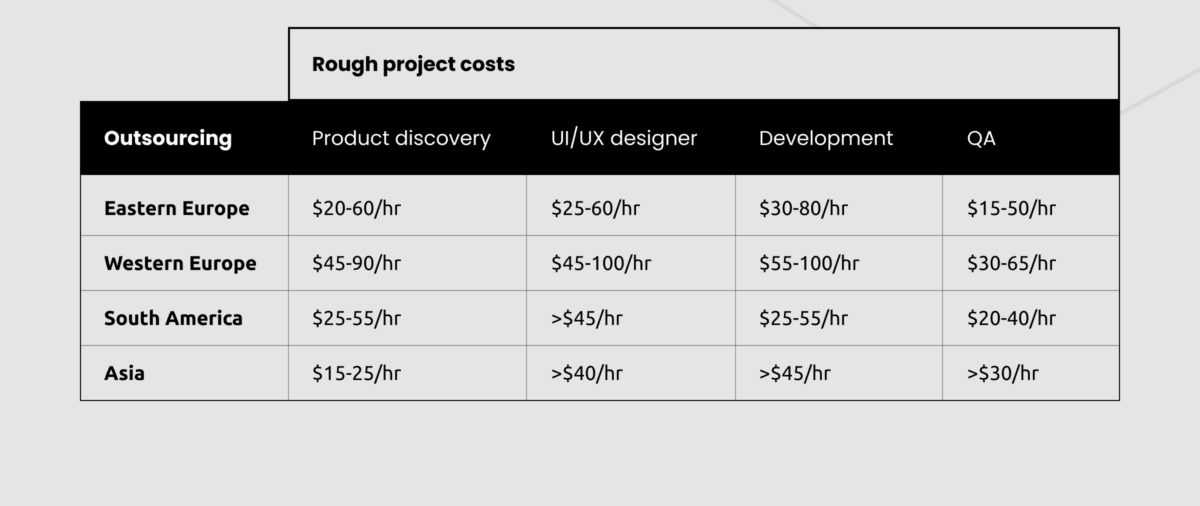

Since each marketplace project has its own goals, type, and requirements, the final cost can differ. To help you with calculations, we’ve estimated the approximate cost of creating a service marketplace depending on the region and project stage.
Service marketplace platform: final words
Taking on a particular business niche is always tricky and involves significant risks. However, this can only mean that you will need to choose the right niche to cover the supply, an experienced software development team, and full-proof planning to build a service marketplace.
RewiSoft has rich experience developing custom online product/service marketplaces of the highest quality across different industries.
Our proven track record of successful cases includes service marketplaces like a job search platform that allows companies to find their ideal candidates, product marketplaces – a platform that operates in the FMCG retail market and lets sellers display any item online by only charging a certain fee), loan marketplace – a platform that helps lending investments or to obtain financing.
So, all you need is to share your ideas with us so we can create a well-polished roadmap to deliver a service marketplace that works for you best!
We can help you create a feasible marketplace development plan that fits your needs and available budget







